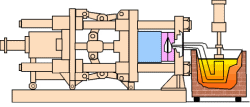DIE CASTING ZINC Various metal alloys are used in the production of parts using the die casting process. Tin and lead were the first metals that were used in die casting of metal printer’s types. Throughout the years, a number of other metals ensued as medium for die casting parts. Among the most popular metal alloys are zinc. Various types of zinc parts are usually made using the die casting process. All types of zinc parts can be relied on for their strength and durability. Zinc parts also come in a broader range of shapes and sizes since zinc is more capable of producing multi-cavity complex shapes than most other metal alloys.
The die casting process involves the injection of molten metal into dies made of hardened tool steels. Over a century ago, molten metal was sqeezed into casts or molds to manufacture axe heads. From simple shapes, die casting technology has improved the process to be able to manufacture more complex shapes. Now, there are two processes for die casting: the hot-chamber method and the cold-chamber method. In the hot-chamber method, a pool of molten metal is used to fill the steel die while maintaining pressure until the metal hardens in the die. The cold-chamber method, on the other hand, uses separate chambers to melt and then coll the melted metal before injecting them into the dies.
Zinc’s characteristic low burning point makes it flexible enough to be used for both hot-chamber machines and cold-chamber machines. As a result, there are more types of zinc parts manufactured and sold in the market today, with the automotive industry enjoying the largest share in the output of zinc die casts.

To get a price for zinc die casting parts or zinc die casting tooling, call toll free 800-524-8083 and ask for sales. Or email us at
sales@diecastingzinc.com for a fast response on a price quote.
Die Casting Zinc Company Blog gives information on how to get a zinc die casting part for manufacturers. If you are looking for Die Casting Zinc Parts or if you need Miniature Zinc Die Casting Parts will give you more information you can use for manufacturing.


